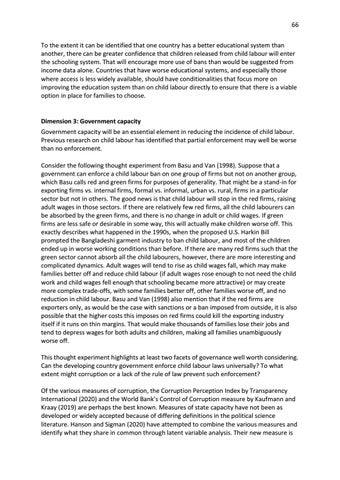66 To the extent it can be identified that one country has a better educational system than another, there can be greater confidence that children released from child labour will enter the schooling system. That will encourage more use of bans than would be suggested from income data alone. Countries that have worse educational systems, and especially those where access is less widely available, should have conditionalities that focus more on improving the education system than on child labour directly to ensure that there is a viable option in place for families to choose.
Dimension 3: Government capacity Government capacity will be an essential element in reducing the incidence of child labour. Previous research on child labour has identified that partial enforcement may well be worse than no enforcement. Consider the following thought experiment from Basu and Van (1998). Suppose that a government can enforce a child labour ban on one group of firms but not on another group, which Basu calls red and green firms for purposes of generality. That might be a stand-in for exporting firms vs. internal firms, formal vs. informal, urban vs. rural, firms in a particular sector but not in others. The good news is that child labour will stop in the red firms, raising adult wages in those sectors. If there are relatively few red firms, all the child labourers can be absorbed by the green firms, and there is no change in adult or child wages. If green firms are less safe or desirable in some way, this will actually make children worse off. This exactly describes what happened in the 1990s, when the proposed U.S. Harkin Bill prompted the Bangladeshi garment industry to ban child labour, and most of the children ended up in worse working conditions than before. If there are many red firms such that the green sector cannot absorb all the child labourers, however, there are more interesting and complicated dynamics. Adult wages will tend to rise as child wages fall, which may make families better off and reduce child labour (if adult wages rose enough to not need the child work and child wages fell enough that schooling became more attractive) or may create more complex trade-offs, with some families better off, other families worse off, and no reduction in child labour. Basu and Van (1998) also mention that if the red firms are exporters only, as would be the case with sanctions or a ban imposed from outside, it is also possible that the higher costs this imposes on red firms could kill the exporting industry itself if it runs on thin margins. That would make thousands of families lose their jobs and tend to depress wages for both adults and children, making all families unambiguously worse off. This thought experiment highlights at least two facets of governance well worth considering. Can the developing country government enforce child labour laws universally? To what extent might corruption or a lack of the rule of law prevent such enforcement? Of the various measures of corruption, the Corruption Perception Index by Transparency International (2020) and the World Bank’s Control of Corruption measure by Kaufmann and Kraay (2019) are perhaps the best known. Measures of state capacity have not been as developed or widely accepted because of differing definitions in the political science literature. Hanson and Sigman (2020) have attempted to combine the various measures and identify what they share in common through latent variable analysis. Their new measure is













